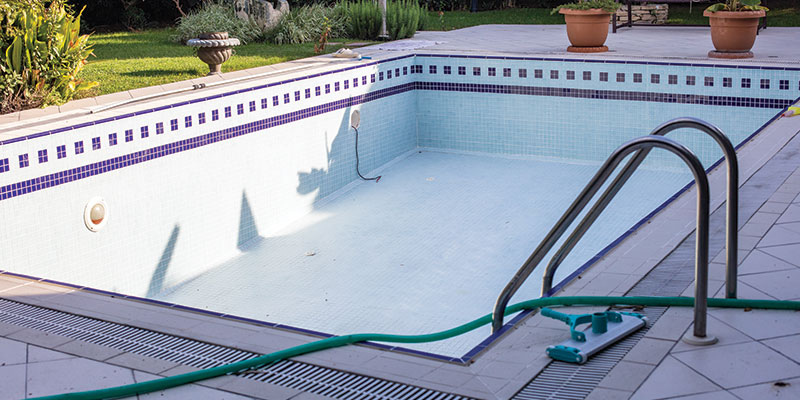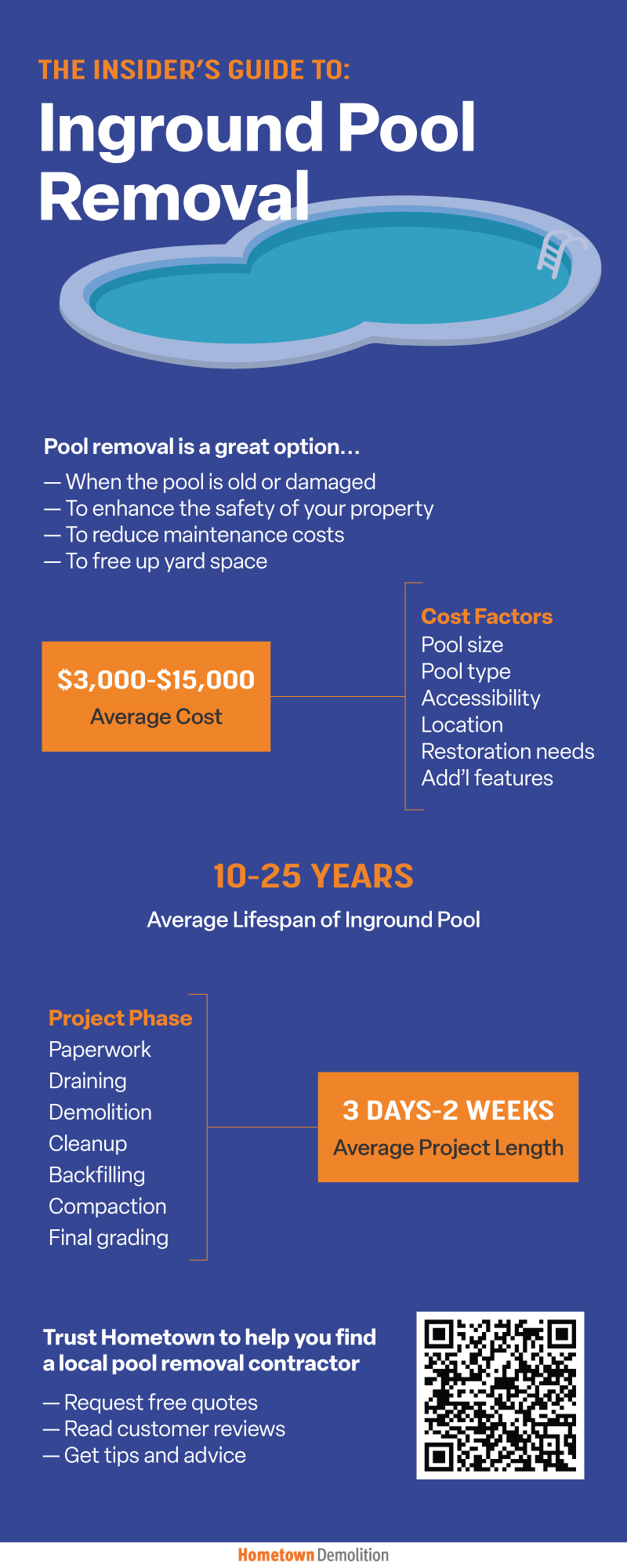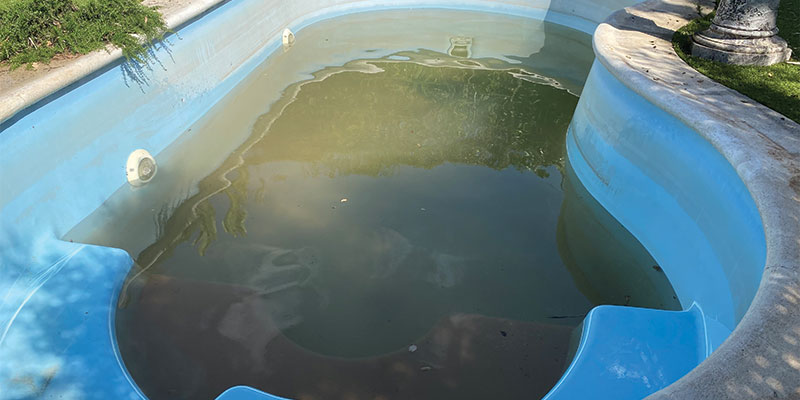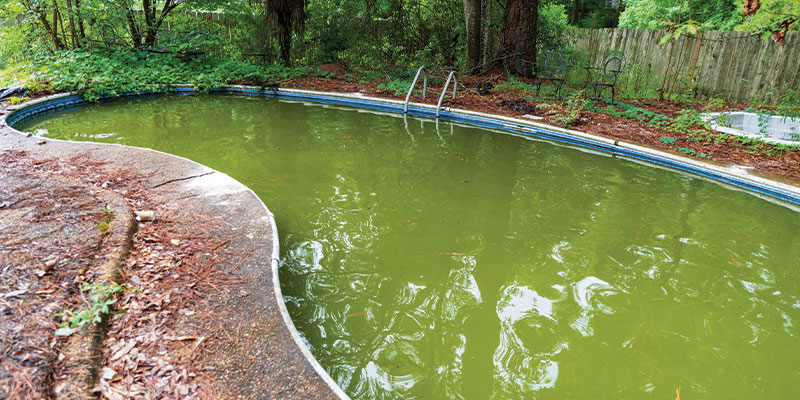
Updated March 15, 2024
Thinking of removing your inground pool?
Whether it's due to safety concerns, maintenance costs, or simply wanting to reclaim your yard space, pool removal is a significant decision that requires careful consideration.
In this blog, we'll explore everything you need to know about inground pool removal, from reasons to remove a pool to the process, costs, and environmental considerations. Join us as we dive into the world of inground pool removal and discover the steps involved in transforming your backyard oasis.
Jump to:
- What are the reasons for removing an inground pool?
- How much does inground pool removal cost?
- Will removing the pool increase my property value?
- What is the process for removing an inground pool?
- How long does it take to remove an inground pool?
- Will removing the pool damage my yard or landscaping?
- Do I need a permit to remove an inground pool?
- Can I remove the pool myself, or do I need to hire a professional?
- What are the options for filling in the space left by the pool?
- Will removing the pool affect my homeowners insurance?
- Are there any environmental considerations when removing an inground pool?
- How can I ensure that the pool removal is done safely and properly?
- Can the pool removal process be customized to fit my specific needs or budget?
- Are there any additional costs or considerations I should be aware of?
- How can I maintain the area after the pool is removed?
- Will removing the pool affect my property taxes?
- Can I repurpose any of the materials from the pool removal?
- How can I choose a reputable contractor for the pool removal?
- Are there any legal considerations or regulations I should be aware of?
- What is the expected lifespan of an inground pool, and how does this affect my decision to remove it?
Find inground pool removal near me

Why Remove an Inground Pool
There are several reasons why homeowners may consider removing an inground pool. Safety concerns are a primary driver, especially for older pools that may no longer meet safety standards, posing a risk to children and pets. Maintenance costs can also be a significant factor, as pools require regular cleaning, chemical treatments, and repairs, which can be expensive. Some homeowners find that they don't use their pool enough to justify the maintenance and cost, especially if their lifestyle has changed.
Additionally, removing a pool can free up yard space for other landscaping or outdoor living features, such as a garden, patio, or lawn. Property value can also play a role, as removing a pool can sometimes increase property value, particularly if the pool is in poor condition or if the space can be better utilized. Aesthetic reasons, such as preferring the look of the yard without a pool, and environmental concerns, such as the inefficiency and wastefulness of older pools in terms of water and energy usage, can also drive homeowners to remove their inground pool.
Read more:
- Should I Upgrade My Pool or Remove It?
- Before and After: Transforming Your Backyard with Inground Pool Removal
How Much Inground Pool Removal Costs
The cost of inground pool removal can vary widely depending on several factors. On average, the cost ranges from $3,000-$15,000 or more.
Factors that can affect the cost to remove an inground pool include:
- Size and complexity of the pool
- Access to the pool for equipment
- Type of pool (e.g., concrete, fiberglass, vinyl)
- Location
- Extent of restoration needed
- Additional features like decks or fences
Generally, larger pools or pools with intricate designs will cost more to remove. The type of pool also plays a significant role, with concrete pools typically being more expensive to remove than fiberglass or vinyl pools. Location can also impact costs, with labor rates, disposal fees, and permit costs varying by region. Additionally, the extent of restoration required after removal, such as filling, compacting, and landscaping the area, will affect the total cost. It's advisable to get estimates from reputable pool removal companies based on your specific situation to get a more accurate idea of the cost.
Keep reading: How Pool Replacement Works and How Much It Costs
How Inground Pool Removal Affects Property Value

The impact of removing an inground pool on property value can vary depending on various factors. In some cases, removing a pool can increase property value, especially if the pool is in poor condition or if the space can be better utilized for other purposes, such as landscaping or outdoor living areas. However, the increase in property value may not always offset the cost of pool removal.
Additionally, the impact on property value can be influenced by local market conditions, buyer preferences, and the overall condition and appeal of the property. We recommend consulting with real estate professionals familiar with your local market to determine the potential impact on property value in your specific situation.
Find inground pool removal near you
Inground Pool Removal Process
The process for removing an inground pool typically involves several steps:
Permits and Approvals
Before starting the removal process, you may need to obtain permits from your local government and obtain any necessary approvals, especially if the pool removal involves significant excavation or disposal of materials.
Draining the Pool
The first step is to drain the pool completely. This may involve using a pump to remove the water.
Demolition
Once the pool is drained, the next step is to demolish the pool structure. The method of demolition will depend on the type of pool and can involve breaking up the concrete, cutting and removing fiberglass or vinyl, or a combination of methods.
Removal of Debris
After the pool structure is demolished, the debris is removed from the site. This may involve hauling it away with heavy equipment.
Backfilling
Once the pool is removed, the hole left behind is backfilled with fill dirt or other suitable material. This is done in layers and compacted to ensure stability.
Compaction and Leveling
The backfilled area is then compacted and leveled to prepare it for landscaping or other use.
Final Grading and Landscaping
The final step is to grade the area and add landscaping or other features as desired.
Throughout the process, it's important to work with a qualified pool removal contractor to ensure that the work is done safely and in compliance with local regulations.
How Long It Takes to Remove an Inground Pool
The time it takes to remove an inground pool can vary depending on several factors, including the size and complexity of the pool, access to the pool, the type of pool, and the extent of restoration needed. On average, the process can take anywhere from a few days to a couple weeks.
For example, a small and simple pool may be removed in a few days, while a larger or more complex pool may take longer. Factors such as the need for demolition, debris removal, backfilling, and restoration can all affect the overall timeline.
It's advisable to consult with a pool removal contractor to get a more accurate estimate based on your specific situation.
How Inground Pool Removal Affects Landscaping
The process of removing an inground pool can have some impact on your yard and landscaping, but a reputable contractor will take steps to minimize damage. The extent of damage can depend on factors such as the size and type of pool, access to the site, and the condition of the yard and landscaping.
During the pool removal process, heavy machinery and equipment will be used, which can cause some disruption to the yard. However, a professional contractor will take care to minimize damage by using equipment that is appropriate for the site and by taking precautions to avoid damaging surrounding landscaping.
After the pool has been removed, the area will need to be backfilled and compacted, which can also have some impact on the yard. However, a skilled contractor will work carefully to ensure that the area is restored as much as possible, and they may offer landscaping services to help restore the yard to its original condition.
Overall, while there may be some temporary disruption and damage during the pool removal process, a professional contractor will work to minimize these impacts and restore the area to its original condition as much as possible.
Find inground pool removal near me
Inground Pool Removal Permits
In most cases, a permit is required for inground pool removal, especially if the removal involves significant excavation or if there are specific regulations related to pool removal in your area. However, the need for a permit to remove an inground pool can vary depending on your location and the specific requirements of your local government or municipality.
It's important to check with your local government or building department to determine the specific requirements for pool removal in your area. They can provide you with information on whether a permit is required and the steps you need to take to obtain one. Working with a professional pool removal contractor can also help ensure that you comply with any permit requirements and that the removal is done safely and according to local regulations.
DIY Inground Pool Removal vs Hiring a Professional
Removing an inground pool yourself is never recommended due to the complexity and safety risks involved. Removing a pool requires specialized equipment and knowledge to ensure that the job is done safely and effectively.
Hiring a professional pool removal contractor is always the best option, as they have the expertise, experience, and equipment necessary to remove the pool properly. They can also handle any necessary permits and ensure that the removal is done in compliance with local regulations.
Additionally, removing a pool yourself can be extremely time-consuming and labor-intensive, and you may not achieve the same level of quality or safety as you would with a professional contractor. Overall, hiring a professional is usually the most efficient and safest option for removing an inground pool.
Options for Filling in the Space Left by the Pool
After an inground pool is removed, homeowners have several options for filling in the space left behind. One common option is fill dirt, which is used to bring the area up to the surrounding ground level and provide a solid base for landscaping or other features. Gravel is another option that can be used as a base or fill material to improve drainage and stability.
Topsoil can be added on top of fill dirt or gravel to provide a fertile layer for planting grass, flowers, or other landscaping. For those looking to create a patio or other hardscape feature in the former pool area, concrete or paving stones can be used to fill in the space. Artificial turf is also an option for creating a low-maintenance, green space in the former pool area.
Homeowners can also choose to plant grass, flowers, shrubs, or trees in the former pool area to create a new garden or landscaping feature. The best option for filling in the space left by the pool will depend on the homeowner's budget, aesthetic preferences, and how they plan to use the area. A professional landscaping contractor can help homeowners choose the right option for their needs and create a plan for transforming the former pool area into a functional and attractive space.
Learn more: Choose the Right Inground Pool Removal Method
How Pool Removal Affects Homeowners Insurance
Removing an inground pool can potentially affect your homeowners insurance, but the impact can vary depending on your insurance provider and policy. In some cases, removing a pool may result in a lower insurance premium, as pools can be considered an "attractive nuisance" that increases the risk of accidents and liability claims.
On the other hand, if the pool removal involves significant changes to your property, such as adding new landscaping or hardscaping features, your insurance provider may need to adjust your coverage to reflect these changes. It's advisable to contact your insurance provider before removing your pool to discuss any potential impacts on your policy and coverage. They can provide you with specific information based on your policy and help you understand how the pool removal may affect your homeowners insurance.
Find inground pool removal near you
Environmental Considerations When Removing an Inground Pool
There are several environmental considerations to keep in mind when removing an inground pool. One of the primary concerns is the proper disposal of materials from the pool, such as concrete, fiberglass, or vinyl. These materials can be recycled in some cases, which can help reduce waste and environmental impact.
Another consideration is the use of chemicals in the pool water. Before draining the pool, it's important to properly dispose of any chemicals, such as chlorine or other sanitizers, to prevent them from contaminating the soil or groundwater.
Additionally, the excavation process can disturb the soil and surrounding vegetation, potentially affecting local ecosystems. It's important to work with a contractor who is experienced in pool removal and can minimize environmental impact by using best practices for excavation and disposal.
Overall, by carefully considering these environmental factors and working with a knowledgeable contractor, you can help ensure that the pool removal process is done in an environmentally responsible manner.
How to Ensure Pool Removal Is Done Safely and Properly

To ensure that the pool removal is done safely and properly, it's important to follow these steps:
-
Hire a Reputable Contractor: Choose a contractor who is experienced in pool removal and has a good reputation. Ask for references and check online reviews to ensure that they have a track record of quality work.
-
Obtain Necessary Permits: Before starting the pool removal process, make sure to obtain any required permits from your local government or municipality.
-
Drain the Pool Properly: Ensure that the pool is completely drained before any demolition or excavation begins.
-
Use Proper Equipment: The contractor should use proper equipment and techniques for removing the pool to minimize damage to your property and ensure safety.
-
Dispose of Materials Properly: Dispose of materials from the pool, such as concrete, fiberglass, or vinyl, in accordance with local regulations. Consider recycling these materials if possible.
-
Restore the Area: After the pool is removed, restore the area with fill dirt, topsoil, or other materials to ensure stability and prevent erosion.
-
Consider Environmental Impact: Be mindful of the environmental impact of the pool removal process and take steps to minimize it, such as proper disposal of chemicals and recycling of materials.
By following these steps and working with a reputable contractor, you can ensure that your pool removal is done safely and properly.
How to Customize the Pool Removal Process to Fit Your Need and Budget
The pool removal process can often be customized to fit your specific needs and budget. A reputable pool removal contractor will work with you to understand your goals and budget constraints and develop a plan that meets your needs.
For example, if you're looking to minimize costs, the contractor may suggest options such as partial pool removal or using less expensive fill materials. If you have specific landscaping plans for the area, the contractor can tailor the removal process to accommodate these plans.
It's important to communicate openly with your contractor about your needs and budget so that they can develop a plan that works for you. They may also be able to offer financing options or other solutions to help make the pool removal process more affordable.
Learn more: Choose the Right Inground Pool Removal Method
Additional Cost Considerations to Be Aware Of
When considering inground pool removal, there are several additional costs and considerations to be aware of. One factor is permit fees, which may be required depending on your location. These fees can add to the overall cost of the project. Additionally, disposing of materials from the pool, such as concrete, fiberglass, or vinyl, may incur additional fees, especially if recycling options are limited.
After the pool is removed, you may also need to consider restoration costs. This can include filling the area with fill dirt, topsoil, or other materials to restore the site. Landscaping the area after the pool removal is another potential cost to be aware of.
Access issues to the pool area, such as limited space for equipment, can affect the cost and complexity of the removal process. Disconnecting and removing utilities connected to the pool, such as plumbing or electrical lines, can also add to the cost.
Finally, there may be unforeseen challenges during the removal process, such as encountering unexpected obstacles or issues with the pool structure. These challenges can affect the cost and timeline of the project. It's important to discuss these potential costs and considerations with your pool removal contractor to ensure that you have a clear understanding of the total cost of the project.
How to Maintain the Area after the Pool Is Removed
After the pool is removed, there are several steps you can take to maintain the area and ensure that it remains in good condition. Firstly, ensure that the area where the pool was removed is filled with fill dirt or other suitable material and compacted to prevent settling. Grading the area is also important to ensure proper drainage away from your home and prevent pooling water.
Consider landscaping the area with grass, plants, or other landscaping features to enhance the appearance of the space. Regular maintenance is key to keeping the area free of debris and ensuring that it remains in good condition. Inspect the area regularly for any signs of erosion or settling.
If you're looking to use the space for outdoor living, consider installing a patio or deck to create a functional and attractive space. By taking these steps, you can ensure that the area remains in good condition and can be enjoyed for years to come.
How Pool Removal Affects Property Taxes
The impact of removing an inground pool on your property taxes can vary depending on your location and local tax laws. In some cases, removing a pool may result in a decrease in property taxes, especially if the pool was adding value to your property.
However, the impact on property taxes can vary widely depending on the specific circumstances of your property and local tax laws. It's advisable to consult with a local tax assessor or real estate professional to determine how removing your pool may affect your property taxes. They can provide you with specific information based on your property and location.
Find inground pool removal near me
How to Repurpose Materials from the Pool Removal
Yes, you can often repurpose materials from the pool removal. For example, concrete from the pool can be crushed and used as fill material for other projects. Fiberglass can sometimes be recycled or repurposed for other applications.
Before repurposing any materials, it's important to check with your pool removal contractor to ensure that it's safe and appropriate to do so. They can provide guidance on the best way to repurpose materials from your pool removal and help you determine if there are any recycling or repurposing options available in your area.
How to Choose a Reputable Contractor for Inground Pool Removal
Choosing a reputable contractor for your pool removal is crucial to ensure the job is done safely and properly. Start by researching pool removal contractors in your area, looking for companies with experience and positive reviews. Ask the contractor for references from past customers and follow up with them to ask about their experience.
Check that the contractor is licensed, bonded, and insured to protect you in case of accidents or damage. Get quotes from several contractors to compare prices and services, but be wary of significantly lower quotes. Ask about the contractor's process for removing the pool, including handling utilities and restoring the area.
Once you've chosen a contractor, get a written contract outlining the scope of work, timeline, and cost. This will protect you in case of disputes. By following these tips, you can choose a reputable contractor for your pool removal and ensure the job is done properly.
Trust Hometown to help you find a qualified local inground pool removal contractor. We make it easy to request free quotes from multiple local pros, read customer reviews, get answers to common pool removal questions, and be sure your project goes off without a hitch.
Legal Considerations or Regulations to Be Aware Of
When removing an inground pool, it's important to be aware of several legal considerations and regulations.
Firstly, you will need permits from your local government or municipality, especially if the removal involves significant excavation.
Disposal of materials from the pool, such as concrete, fiberglass, or vinyl, must also comply with local regulations, which may include recycling options or specific disposal sites.
If the pool is connected to utilities, such as plumbing or electrical lines, they will need to be properly disconnected and removed according to local regulations.
Additionally, ensure that the pool removal process does not encroach on neighboring properties or violate any property boundaries.
Be mindful of environmental regulations related to the pool removal process, such as proper disposal of chemicals.
When hiring a contractor, ensure they are licensed, bonded, and insured, and comply with all local regulations and building codes. Consulting with local authorities or a legal professional can help ensure compliance with all relevant legal considerations and regulations.
Expected Lifespan of an Inground Pool
The expected lifespan of an inground pool can vary depending on several factors, including the type of pool, quality of construction, and level of maintenance.
Generally, a well-maintained concrete or gunite pool can last 20-30 years or more, while fiberglass pools can last 25 years or more.
Vinyl liner pools may need their liners replaced every 7-15 years, but with proper maintenance, the underlying structure can last several decades.
Regular maintenance, including proper cleaning, chemical balancing, and upkeep of equipment, can help extend the lifespan of an inground pool.


